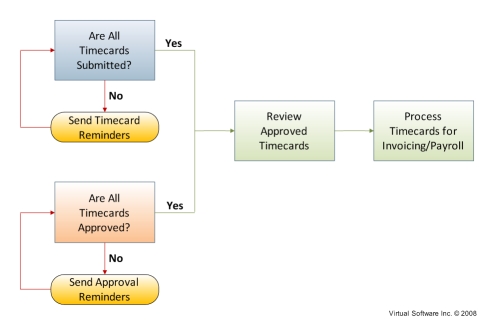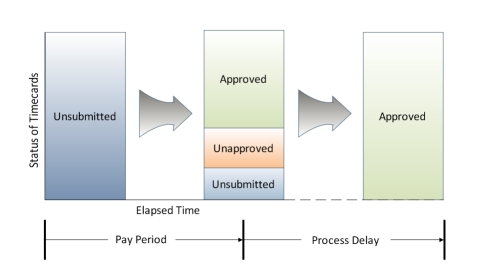Overview of Processing in Virtual Time+Expense
 |
For any business, managing time and expense data is associated with a common recurring goal: ensuring that all information has been submitted, approved, and delivered to the accounting department. Typically, at the end of your predefined time period (pay cycle, invoicing cycle) one must assess two questions: Do I have all my timecards? Do I have all my expense reports? Gathering this information involves many people, and typically the information can not be found in one place. For example, if an employee has not submitted their timecard you must call them to determine the reason, or if a manager has not approved an expense report, you must remind them to do so. In most cases, a company can not close out a period of time until all information is approved and in the hands of the accounting department.
The following figure shows this workflow:
|
As an example, lets say your company pays on a weekly cycle. The company has hourly employees, and tracks billable time spent at several customer sites as well as non-billable general or administrative time. Time spent at customer sites requires that company’s approval, while general or administrative time is approved by an internal manager.
Starting on the first day of each new week you begin the task of closing the previous week, which cannot be completed until all approved timecards have been collected. After reviewing the previous week’s information, you determine that you have received all of the timecards from the respective managers except for two. After contacting the delinquent employees, you learn that one was submitted but is pending approval, and the other forgot to submit the timecard to their manager. You remind the one employee to submit his timecard asap, and then send an email to the other manager to expedite her approval. The next day you once again check the status of the two delinquent timecards, and find they have both been approved and are waiting in your inbox. With all timecards approved and received, you are now ready to close the previous week to run payroll and invoice your customers.
This simple scenario illustrates the time delay, while information is still being gathered, before a period can be closed. The more employees, contractors, managers, and customers that are involved in this process, the more complex it becomes and the longer it takes. It is in the best interest of you and your company to minimize this delay.
|
Virtual Time+Expense and Processing Data
Virtual Time+Expense allows you to perform all the above tasks from one central area called "To Be Processed". This screen is a birds-eye-view of all your current pending time and expense data, and provides the tools to act on this information. By utilizing these tools effectively, you can stay on top of and expedite all delinquencies - saving you time and minimizing the delay to close each period.
The tasks you can perform from the To Be Processed area include:
- Find all timecards that haven't been submitted for a given week, and send email reminders to any or all users, whether you have 1 or 100, with a single mouse click
- View all timecards and expense reports that have not yet been approved, and send email reminders to any or all approvers
- Review all approved timecards and expense reports, with the ability to make changes if necessary
- Enter timecards and expense reports on behalf of any user
When you have reviewed this data, the final step you perform is to "Process" it. Processing encompasses two things: the accounting level of approval, and preparing the information to be exported for invoicing (from the Billables area) and payroll (from the Payables area).
Although we have referred to working with the previous periods data, the To Be Processed area (along with most other areas within Virtual Time+Expense) show you all pending information - in this case, all timecards and expense reports that have not yet been processed. As you process data, this "to do" list clears as information flows to the next stage in the workflow. If you close each period regularly there really is no difference, but if you don't, this concept allows nothing to be lost - by showing you all pending information without making you search for it.
The goal in Virtual Time+Expense is to get all data through the entire workflow cycle - to do this you need to eventually approve, process, bill and pay all information.
| Next steps: |
 Overview of Billables Overview of Billables
|
 Overview of Payables Overview of Payables
|
 Details for the To Be Processed area Details for the To Be Processed area
|

